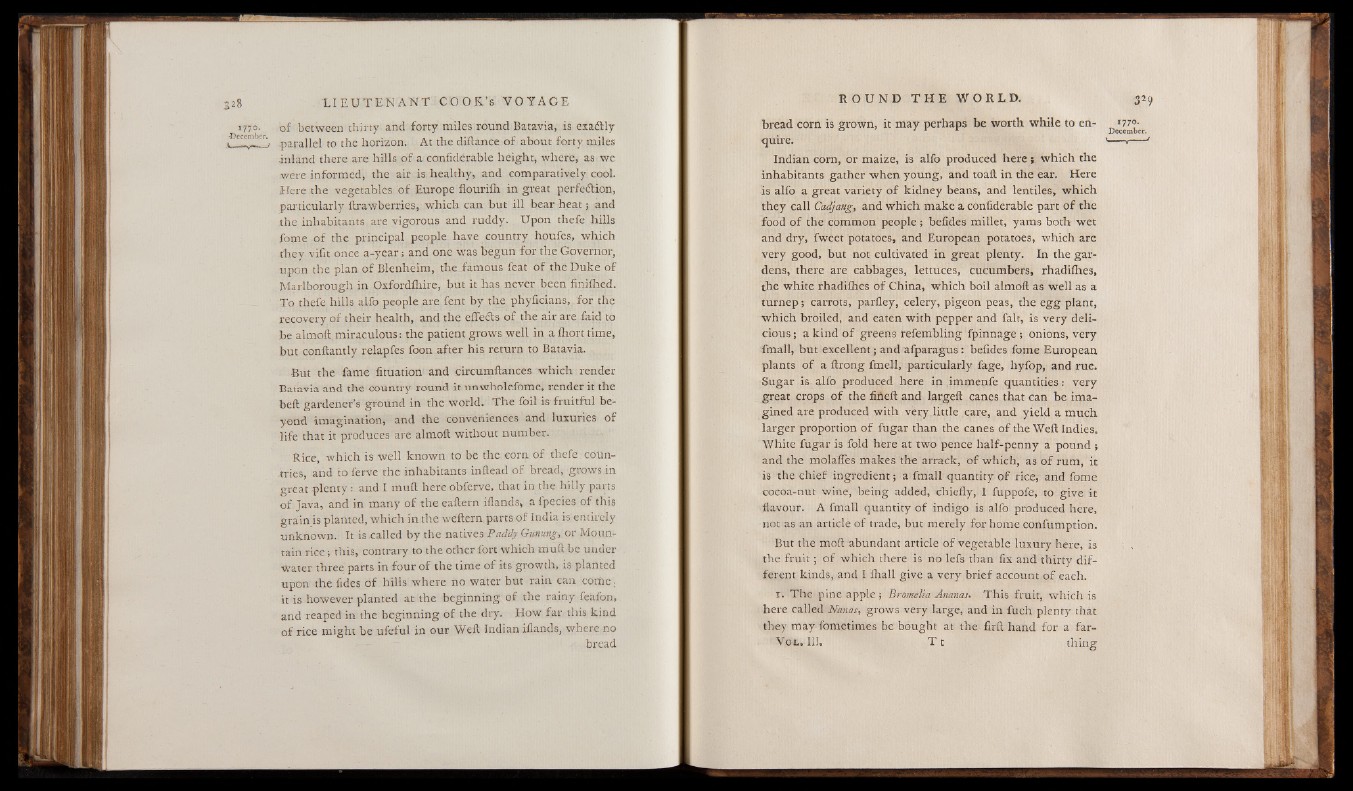
3 2 8 L I E U T E N A N T C Ö O K ’ s V O Y A G E
1770. of between thirty and forty miles round Batavia, is exafify
Pccember., parajjej t0 horizon. At the diftance of about forty miles
•inland there are hills of a confiderable height, where, as we
were informed, the air is healthy, and comparatively cool.
Here the vegetables of Europe flourifh in great perfection,
particularly ltrawberries, which can but ill bear heat; and
the inhabitants are vigorous and ruddy. Upon thefe hills
fome of the principal people have country houfes, which
they vifit once a-year; and one was begun for the Governor,
upon the plan of Blenheim, the famous feat of the Duke of
Marlborough in Oxfordlhire, but it has never been finilhed.
To thefe hills aifo people areTent by the phyficians, for the
recovery of their health, and the effects of the air are faid to
be ahnoft. miraculous: the patient grows well in a fliort time,
but conftantly relapfes foon after his return to Batavia.
But the fame fituation and circumftances which render
Batavia and the country round it unwholefome, render it the
beft gardener’s ground in the world. The foil is fruitful beyond
imagination, and the conveniences and luxuries of
life that it produces are almoft without number.
Rice, which is well known to be the corn of thefe countries,
and to ferve the inhabitants inftead of bread, grows in
great plenty : and I muft here obferve, that in the hilly parts
of Java, and in many of the eaftern iflands, a fpecies of this
grain is planted, which in the weftern parts of India is entirely
unknown. It is.called by the natives Paddy Gunung, or Mountain
rice; this, contrary to the other fort which muft be under
water three parts in four of the time o f its growth, is planted
upon the fides of hills where no water but rain can come;
it is however planted at the beginning of the rainy feafon,
and reaped in the beginning of the dry. How far this kind
of rice might be ufeful in our Weft Indian iflands, where no
bread
R O U N D T H E WORLD. 3J9
bread corn is grown, it may perhaps be worth while to en-
quire. v----
Indian corn, or maize, is alfo produced here; which the
inhabitants gather when young, and toaft in the ear. Here
is alfo a great variety of kidney beans, and lentiles, which
they call Cadjang, and which make a confiderable part of the
food of the common people; befides millet, yams both wet
and dry, fweet potatoes, and European potatoes, which are
very good, but not cultivated in great plenty. In the gardens,
there are cabbages, lettuces, cucumbers, rhadifhes,
the white rhadifhes of China, which boil almoft as well as a
turnep; carrots, parfley, celery, pigeon peas, the egg plant,
which broiled, and eaten with pepper and fait, is very delicious;
a kind of greens refembling fpinnage ; onions, very
fnrall, but excellent; and afparagus: befides fome European
plants of a ftrong fmell, particularly fage, hyfop, and rue.
Sugar is alfo produced here in immenfe quantities: very
great crops of the fineft and largeft canes that can be imagined
are produced with very little care, and yield a much
larger proportion of fugar than the canes of the Weft Indies.
White fugar is fold here at two pence half-penny a pound ;
and the molafles makes the arrack, of which, as of rum, it
is the chief ingredient; a fmall quantity of rice, and fome
cocoa-nut wine, being added, chiefly, I fuppofe, to give it
flavour. A fmall quantity of indigo is alfo produced here,
not as an article of trade, but merely for home confumption.
But the moft abundant article of vegetable luxury here, is
the fru it; of which there is no lefs than fix and thirty different
kinds, and I fhall give a very brief account of each.
1. The pine apple ; Bromelia Ananas- This fruit, which is
here called Nanas, grows very large, and in fuch plenty that
they may fometimes be bought at the firft hand for a far-
Vol. III. T t thing